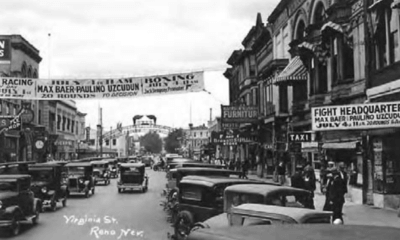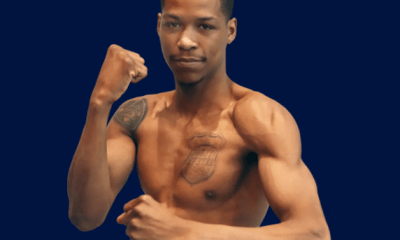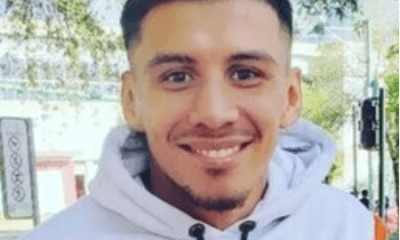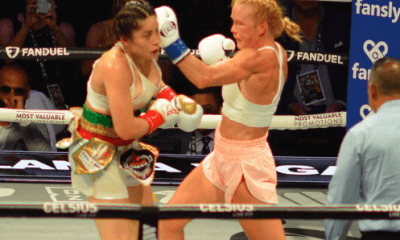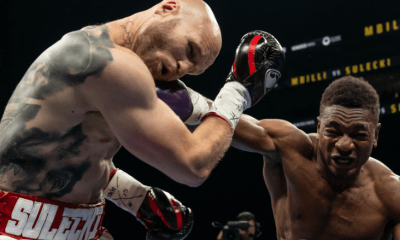Featured Articles
The Hauser Report: Showtime Says Goodbye to Boxing and More Notes
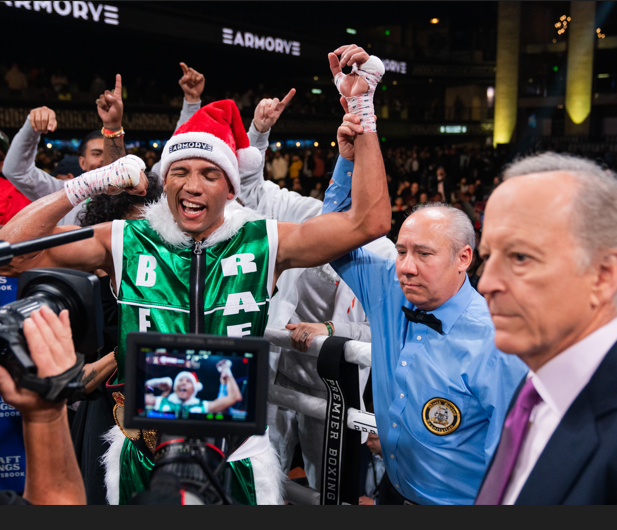
On October 17, Paramount Global announced that it was closing the Showtime sports department and shutting down the network’s boxing program after a 37-year run.
Showtime televised its first fight on March 15, 1986 – a replay of Marvelous Marvin Hagler’s eleventh-round knockout of John Mugabi five days earlier. In the years that followed, it televised more than two thousand fights. In the early-1990’s, the network turned its boxing programming over to Don King in order to gain rights to Mike Tyson’s fights. More recently, Premier Boxing Champions enjoyed favored status.
Showtime was the launching pad for UK imports like Naseem Hamed, Ricky Hatton, and Joe Calzaghe in the United States. Its most notable telecasts included numerous Mike Tyson outings, the first fight between Diego Corrales and Jose Luis Castillo, Floyd Mayweather vs. Canelo Alvarez, and the “Super Six” super-middleweight championship tournament that saw the emergence of Andre Ward as the best 168-pound fighter in the world. It collaborated with HBO to produce Lennox Lewis vs. Mike Tyson, Floyd Mayweather vs. Manny Pacquiao, and Anthony Joshua vs. Wladimir Klitschko, and advanced the careers of myriad young prospects on ShoBox: The New Generation.
Steve Albert, Ferdie Pacheco, Al Bernstein, Steve Farhood, Barry Tompkins, Nick Charles, and Paulie Malignaggi were among the quality commentators who contributed to the soundtrack that the network provided for the contemporary boxing scene.
Less laudably, Showtime reveled in the highly lucrative but homophobic-misogynistic-fueled promotion of Floyd Mayweather vs. Conor McGregor. And in recent years, it shifted an increasing number of fan-friendly fights from “regular” Showtime to Showtime-PPV.
Like HBO, Showtime ended its sojourn through boxing with a mundane fight card. HBO’s final offering (on December 8, 2018) was a pedestrian event that featured Cecelia Braekhus, Claressa Shields, and Juan Francisco Estrada. On December 16, Showtime gave us David Morrell vs. Sena Agbeko, Chris Colbert vs. Jose Valenzuela, and Andre Berto vs. Robert Guerrero.
The show opened with Berto-Guerrero. Berto has won two fights dating back to 2015 and had last fought more than five years ago. Guerrero had lost five of eleven bouts dating back to 2013. Both men are forty years old and, on Saturday night, they fought like it. Guerrero won a 99-91, 98-92, 98-92 decision over the course of ten dreary rounds.
Then Jose Valenzuela (who was coming in off two losses in a row) knocked Chris Colbert unconscious with a right hook in round six.
In the finale, David Morrell (a 12-to-1 favorite) stopped a woefully overmatched Sena Agbeko at 1:43 of the second stanza. Agbeko was never in the fight.
The telecast began with a short video montage of images from past Showtime fights followed by remarks about the occasion from Brian Custer. After Berto-Guerrero, there was a brief video tribute to the sport of boxing. Later in the telecast, Steve Farhood narrated a segment on the history of ShoBox.
The members of the announcing team spent a lot of time praising each other. There was no acknowledgement of Jay Larkin (a key architect of Showtime’s boxing program). Nor was Steve Albert (Showtime’s blow-by-blow commentator for twenty years) or Ferdie Pacheco (who was paired with Albert) mentioned. A tip of the hat to Ken Hershman (who succeeded Larkin as president of Showtime Sports), Don King (who was a big part of Showtime Boxing), and other key figures in the network’s boxing program who were ignored would also have been appropriate.
But back to the fights. Goodbyes are important. It would have been better if Showtime Boxing had ended its run with its November 25, 2023, telecast of David Benavidez vs. Demetrius Andrade. Benavidez turned in a star-making performance that night. That would have been a good note to end on with Showtime telling its subscribers, “We brought you some great moments in the past. Now here’s a glimpse of boxing’s future.”
****
There was a time when club fights were boxing’s lifeblood and New York City was home to several fight cards each week. On the night that Showtime bade farewell to the sweet science, Larry Goldberg promoted his ninth club-fight card at Sony Hall in New York.
Goldberg is the only promoter now running fight cards on a regular basis in New York. This was his ninth show at Sony Hall in the past fourteen months and he has three dates penciled in for the first six months of 2024.
Too many club fights cards today consist almost exclusively of non-competitive beatdowns. Two of the six fights on Goldberg’s card were particularly good match-ups.
Jacob Riley Solis (a 32-year-old New Yorker who was making his pro debut) took on Tevin Terrance (a 1-and-0 import from Canada). Terrance fought with all-out aggression and scored a knockdown in the first stanza. Solis has a weak jab that needs to be reconstructed and a good right hand. In round three, the right hands started landing and Terrance was counted out.
Cristian Otero (6-4, 2 KOs) vs. Yeuri Andujar (5-6-1, 3 KOs, 3 KOs by) was another competitive action fight. Andujar came into the ring with four losses and a draw in his last five outings. But those numbers are deceiving in that he’d been overmatched against prospects like Bruce Carrington and Robeisy Ramirez. Otero is a club fighter who gives an honest effort every time out. Andujar dropped Otero in round two and finished him with a brutal right hand in round four.
I’d much rather see evenly-matched club fighters who put everything they have into fights that they can win than a parade of mismatches.
***
The International Boxing Hall of Fame recently announced its inductees for 2024. I was disappointed that Flip Homansky (who was on the ballot for the first time) wasn’t chosen for induction. My sense is that too many of the electors don’t understand the trailblazing contributions that Dr Homansky made in advancing the health and safety of fighters during his years at the Nevada State Athletic Commission.
I’d also like to address what I believe is an injustice regarding two men who have never been on the ballot.
Gerry Cooney won his first 23 fights before losing to Larry Holmes on a night when Holmes was as good as he’d ever been or would be ever again. Plagued by substance abuse problems that he conquered after leaving boxing, Cooney retired after losses to Michael Spinks and George Foreman. The only three men to beat him in a boxing ring were first-ballot Hall of Famers. Hall of Fame matchmaker Bruce Trampler ranks Cooney among the top twenty heavyweights of all time.
Cooney never won a world championship. But neither did Jimmy Bivins, Charley Burley, Billy Graham, Cocoa Kid, Lloyd Marshall, Holman Williams, and others who are enshrined in Canastota. He deserved to be on the ballot ahead of Jorge Arce, Vuyani Bungu, Yuri Arbachakov, Leo Gamez, Miguel Lora, Orzubek Navarov and some of the other nominees.
Cedric Kushner was a significant player on the boxing scene for decades. He was best known for promoting heavyweights like Hasim Rahman, Shannon Briggs, Chris Byrd, Ike Ibeabuchi, Jameel McCline, Derrick Jefferson, Kirk Johnson, Axel Schulz, and David Tua, but also built stars like Shane Mosley in other weight classes.
Dan Goossen, Klaus-Peter Kohl, Tito Lectoure, and Mogens Palle are in the Hall of Fame. Kushner was their equal as a promoter and deserved to be on the ballot.
****
The holiday sentiment of peace on Earth seems sadly out of reach this year. But I’d like to recount a story that Yuri Foreman told me years ago.
Foreman was born in Belarus. When he was eleven, his family moved to Israel.
“At first it was difficult,” Yuri recalled. “I was missing my friends. And sometimes in Israel, there was discrimination between the Russians and the Jews. The Russians were also Jewish, but the Israelis would call us Russians and say we didn’t deserve to be there, so there would be fights in school between the immigrants and the Israelis.”
Foreman learned the rudiments of boxing in an outdoor lot. There was no ring, not even a heavy bag.
“They wouldn’t give us a gym because we were just Russians,” he remembered. “We went to City Hall and begged for a place to hang a bag and put up a ring. All they told us was, ‘Go box with the Arabs.’ So finally I went to the Arab gym. The first time I walked in, I saw the stares. In their eyes, there was a lot of hatred. But I needed to box. And boy, did they all want to box me. But after a while, the wall that was between us melted. We all wanted the same thing. I traveled with them as teammates. It helped that I won almost all the time. And finally, we became friends.”
Foreman won the WBA 154-pound title in 2009 by decision over Daniel Santos. Shortly before that fight, the father of one of the boys Yuri had boxed with in the Arab gym called and told him, ‘We follow your career. We’re all rooting for you. We’ll be very proud when you become a champion. After you win, we want you to come to our village for a celebration and we’ll kill the nicest of the sheep for you.”
David Morrell photo compliments of Ryan Hafey / Premier Boxing Champions
Thomas Hauser’s email address is thomashauserwriter@gmail.com. His most recent book – The Universal Sport: Two Years Inside Boxing – was published by the University of Arkansas Press. In 2004, the Boxing Writers Association of America honored Hauser with the Nat Fleischer Award for career excellence in boxing journalism. In 2019, Hauser was selected for boxing’s highest honor – induction into the International Boxing Hall of Fame.
To comment on this story in the Fight Forum CLICK HERE
-

 Featured Articles3 weeks ago
Featured Articles3 weeks agoAvila Perspective, Chap. 330: Matchroom in New York plus the Latest on Canelo-Crawford
-

 Featured Articles2 weeks ago
Featured Articles2 weeks agoVito Mielnicki Jr Whitewashes Kamil Gardzielik Before the Home Folks in Newark
-

 Featured Articles4 weeks ago
Featured Articles4 weeks agoAvila Perspective, Chap 329: Pacquiao is Back, Fabio in England and More
-

 Featured Articles4 weeks ago
Featured Articles4 weeks agoOpetaia and Nakatani Crush Overmatched Foes, Capping Off a Wild Boxing Weekend
-

 Featured Articles3 weeks ago
Featured Articles3 weeks agoCatching Up with Clay Moyle Who Talks About His Massive Collection of Boxing Books
-

 Featured Articles4 weeks ago
Featured Articles4 weeks agoFabio Wardley Comes from Behind to KO Justis Huni
-

 Featured Articles2 weeks ago
Featured Articles2 weeks agoMore Medals for Hawaii’s Patricio Family at the USA Boxing Summer Festival
-

 Featured Articles4 weeks ago
Featured Articles4 weeks agoDelving into ‘Hoopla’ with Notes on Books by George Plimpton and Joyce Carol Oates

